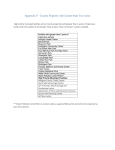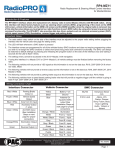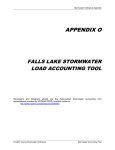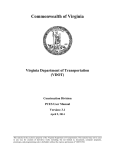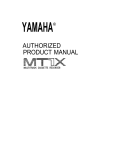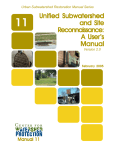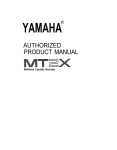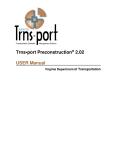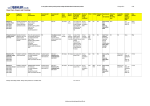Download IDDE Program Plan - Arlington Public Schools
Transcript
ARLINGTON PUBLIC SCHOOLS ILLICIT DISCHARGE DETECTION AND ELIMINATION PROGRAM PLAN Prepared for Arlington Public Schools 2770 South Taylor Street Arlington, Virginia 22207 Prepared by Versar, Inc. 9200 Rumsey Road Columbia, MD 21045 April 15, 2015 Table of Contents TABLE OF CONTENTS Page 1.0 INTRODUCTION.......................................................................................................... 1-1 1.1 SOURCES OF ILLICIT DISCHARGES ............................................................ 1-1 1.2 DETECTION OF ILLICIT DISCHARGES ........................................................ 1-2 1.3 CORRECTION OF ILLICIT DISCHARGES ..................................................... 1-2 2.0 LOCATION AND MAPPING OF OUTFALLS ......................................................... 2-1 3.0 IMPLEMENTATION OF ILLICIT DISCHARGE PREVENTION PLAN .......... 3-1 4.0 DETECTION AND RESOLUTION PROTOCOLS .................................................. 4-1 4.1 BACKGROUND ................................................................................................. 4-1 4.2 INDICATOR ANALYTES ................................................................................. 4-1 4.3 DRY WEATHER SCREENING PROCEDURE ................................................ 4-2 4.4 TRACKING DOWN THE SOURCE OF AN IMPROPER DISCHARGE ........ 4-3 4.5 HEALTH AND SAFETY .................................................................................... 4-3 4.6 DATA MANAGEMENT/QUALITY CONTROL .............................................. 4-4 5.0 SCHEDULE OF PROGRAM PLAN IMPLEMENTATION .................................... 5-1 6.0 ANNUAL REPORT AND PROGRAM EVALUATION ........................................... 6-1 7.0 REFERENCES............................................................................................................... 7-1 APPENDICES A B C D FIELD EQUIPMENT CHECKLIST ................................................................................. A-1 STANDARD OPERATING PROCEDURES FOR DRY WEATHER SCREENING ..... B-1 DATA SHEETS FOR DRY WEATHER SCREENING................................................... C-1 DATA SHEET FOR HOTSPOT INVESTIGATIONS ..................................................... D-1 I:\WPShared\DEPT.74\ARLINGTON\Public Schools\15525-R.docx iii List of Tables LIST OF TABLES Table No. Page 4-1. Dry weather screening parameters and action criteria ..................................................... 4-1 5-1. Arlington Public Schools IDDE program implementation schedule ............................... 5-1 5-2. Prioritized list of sites ...................................................................................................... 5-2 v Introduction 1.0 INTRODUCTION Under the Virginia Pollutant Discharge Elimination System (VPDES) program, stormwater discharge permit holders (or operators) are required to implement plans to detect, isolate, and eliminate improper discharges to the municipal separate storm sewer system (MS4) that is under the operator’s jurisdiction. Improper or illicit discharges to the MS4 are those discharges that do not originate as stormwater runoff. Improper discharges can be hazardous to public health, harmful to aquatic life in receiving waters, and detrimental to overall water quality. Federal regulation defines an improper discharge as any discharge to an MS4 that is not composed entirely of stormwater, except allowable discharges pursuant to a VPDES permit. This Illicit Discharge Detection and Elimination (IDDE) Program Plan has been developed to comply with requirements of Arlington Public Schools’ (APS) VPDES stormwater discharge permit (“Permit”). Specifically, the Permit requires the operator to a) locate and map MS4 outfalls, b) prohibit improper discharges to the MS4, c) develop procedures to detect, identify, and address improper discharges, d) facilitate public reporting of illicit discharges, e) implement the program plan in accordance with the schedule in the Permit, and f) prepare an annual report to document IDDE program activities. This program plan addresses each of these requirements in separate sections below. The IDDE program includes overall efforts by APS to (1) identify and map MS4 outfalls and potential sources of illicit discharge; (2) screen MS4 outfalls for dry weather discharge, the presence of pollutants, or other visible signs of an illicit connection; and (3) isolate and correct the illicit connection. 1.1 SOURCES OF ILLICIT DISCHARGES The Virginia Code defines an illicit discharge as “any discharge to a municipal separate storm sewer that is not composed entirely of stormwater, except discharges pursuant to a VPDES or state permit (other than the state permit for discharges from the municipal separate storm sewer), discharges resulting from fire fighting activities, and discharges identified by and in compliance with 9VAC25-870-400 D 2 c (3).” Improper discharges to the MS4 may be the result of misconnection of a portion of the sanitary sewer system to the storm sewer system, failure of sewer infrastructure allowing infiltration of public drinking water or sanitary sewer effluent into the storm sewer system, inadvertent or deliberate discharges of prohibited effluent to the MS4, or other causes. Center for Watershed Protection and USEPA have published guidance for the implementation of IDDE programs to detect and remediate improper discharges (Brown et al. 2004). Illicit discharges in storm drains consist of measureable flow and contain high concentrations of pollutants and/or pathogens. Dry weather discharges (as described by Brown et al. 2004) can include the following illicit types: sewage and septic flows; public drinking water supply breach; 1-1 Introduction washwater flows, such as residential gray water (laundry) discharges, water from commercial car washes, fleet washing, equipment washdown activity, commercial laundries, and floor washing to shop drains; and liquid wastes such as oil, paint, and industrial process water that enter the storm drain system. Dry weather flows can also be associated with cleaner discharges that would typically not be considered illicit (9VAC25-870-400 D 2 c (3)): water line flushing, landscape irrigation, diverted stream flows, rising groundwaters, uncontaminated groundwater infiltration (as defined in 40 CFR 35.2005(20)), uncontaminated pumped groundwater, discharges from potable water sources, foundation drains, air conditioning condensation, irrigation water, springs, water from crawl space pumps, footing drains, lawn watering, individual residential car washing, flows from riparian habitats and wetlands, dechlorinated swimming pool discharges, and street wash water. Notwithstanding the generally non-illicit nature of the above, all flowing water discharges from the MS4 shall be tested for presence of excessive pollution that would indicate an illicit discharge. 1.2 DETECTION OF ILLICIT DISCHARGES IDDE programs frequently include systematic or targeted screening of storm drain outfalls in priority areas. IDDE programs may include both dry weather screening of storm drain outfalls and investigations of upland sources of pollution as it enters the storm drain system. This plan establishes the protocol for identifying and screening outfalls draining Arlington Public Schools-administered properties. These target facilities are screened on an annual basis for presence of illicit discharge as is required by the school system’s current VPDES MS4 Permit. This Plan also contains the field operations, data management, and response protocols for the IDDE program. 1.3 CORRECTION OF ILLICIT DISCHARGES Outfalls that have been found to be discharging and that have one or more screening parameters that are outside of acceptable ranges will be investigated further to determine the source or cause of the illicit discharge. Any suspected illicit discharges are referred to Arlington County for follow-up and possible enforcement. 1-2 Location and Mapping of Outfalls 2.0 LOCATION AND MAPPING OF OUTFALLS Arlington Public Schools has completed a reconnaissance of the storm drain network and site conditions of properties subject to its jurisdiction. The reconnaissance activities consisted of conducting hotspot investigations (HSIs) and verifying stormwater infrastructure whose configuration a) discharges to a channel or water body that is located on Arlington Public Schools property or b) connects to the storm drain network that is maintained by Arlington County. Hotspot investigations (Wright et al. 2005) consist of investigations of parcels and practices that have the potential to introduce polluted runoff into the storm drain network. Source categories that HSIs examine include: vehicle operations, waste management, storage of liquid and solid materials, fueling operations, loading and unloading activities, and turf management. Hotspot data collected in the field (Appendix D) are used to assist in prioritizing outfall screening or targeted BMP implementation efforts that are required under the school system’s VPDES MS4 discharge Permit. Outfall location data will be entered into Arlington County’s stormwater infrastructure GIS coverage. Outfalls will be assigned an unique identifier that will be referenced when conducting dry weather screening field work. 2-1 Implementation of Illicit Discharge Prevention Plan 3.0 IMPLEMENTATION OF ILLICIT DISCHARGE PREVENTION PLAN Arlington Public Schools, in coordination with Arlington County, implements the IDDE plan within its jurisdiction by conducting outreach, training, and other preventive activities that include: a) educating employees in proper housekeeping techniques on school system properties, b) informing employees of characteristics of an illicit discharge should they encounter polluting conditions, and c) providing employees with contact information to report suspected illicit discharges. Such training is required in Permit condition II B 1. Activities conducted by Arlington Public Schools as operator include the following: Distribution of County statutes or other guidance in the form of flyers or bulletins to staff regarding illicit discharges, Identification of “at risk” sites for prioritization, based on hotspot status and prior history of complaints/issues, Systematic inspections of BMPs and infrastructure, and Systematic as well as incident-based outfall screening. Activities conducted by Arlington County as responsible authority include the following: Distribution of County contact list and web link for reporting by employees, parents, or the public, Enlisting school participation in outreach activities such as storm drain stenciling within the school property, Training school system employees to prevent and recognize illicit discharges, and Designation of responsible personnel to investigate and remediate illicit discharges within APS. 3-1 Detection and Resolution Protocols 4.0 4.1 DETECTION AND RESOLUTION PROTOCOLS BACKGROUND Dry weather MS4 screening programs involve monitoring both physical and chemical characteristics of dry weather flows. If flowing water is present at an outfall during dry weather, the quality of the flowing water is assessed in the field. Water quality testing for indicator pollutants such as detergents and fluoride, and characteristics such as pH, temperature, and turbidity, provides on-the-spot information to help distinguish between improper discharges and other possible sources of dry weather flow, such as groundwater infiltration. Physical indicators in flowing water include odor, color, turbidity, and the presence of floating material such as oil, sewage, or suds (Brown et al. 2004). Physical indicators of a potentially improper discharge are often evident when flow is not present; such indicators include outfall damage, deposits or stains, unfavorable colors or odors in plunge pools, deposits of material in receiving channels, and algal growth in pipes. Field procedures for dry weather screening as well as health and safety procedures common to all components, are described in Sections 4.3 through 4.7. 4.2 INDICATOR ANALYTES Table 4-1 shows the indicator analytes and their ability to aid in detecting various kinds of discharges. Selection was based primarily on information provided in Brown et al. (2004) and the Permit requirement that testing be able to distinguish the type of illicit discharge. Table 4-1. Dry weather screening parameters and action criteria Recommended Analyte total chlorine* Kit or Effluent Type Indicated Probe industrial drinking water sewage photometer single analyte fluoride tap water meter ammonia sewage washwater industrial photometer single analyte surfactants sewage washwater meter (detergents) pH industrial washwater sonde *Exceedance criteria are based on the test range of the field kit Recommended Action Criterion ≥ 0.4 mg/l Instrument Range 0 to 5 mg/l ≥ 0.25 mg/l 0 to 10 mg/l ≥ 1 mg/l 0.2 to 30 mg/l ≥ 0.25 mg/l 0.15 to 1 mg/l ≤ 5 (industrial) 0 to 14 Results of screening tests will be compared to the criteria presented in Table 4-1 to assist in identifying the possible source of a suspected improper discharge or illicit connection. Testing results will be presented in an annual report. 4-1 Detection and Resolution Protocols 4.3 DRY WEATHER SCREENING PROCEDURE Initial dry weather screening activities include assessing the physical characteristics of the outfall and any discharge, and performing screening chemistry tests on the discharge (if present). Field screening will not proceed unless less than 0.10 inches of rainfall has fallen in the preceding 72 hours. Field crews will verify that this dry-time criterion has been met before beginning field operations. The field staff will obtain and gather the materials listed in Appendix A prior to field work on any given day. Standard operating procedures for use, calibration, maintenance, and quality control for all field equipment are provided in Appendix B. For the Arlington Public Schools field investigation effort, screening of outfalls consists of the following: Locate outfalls using GPS and infrastructure maps in the target areas. If the outfall is subsurface, place traffic cones and remove manhole cover. Inspect the selected outfalls for physical evidence of illicit discharge. If flowing water is present, perform water chemistry tests in the field. If the outfall is subsurface, use telescoping sampler arm and cup to obtain sample. Record data on electronic field data sheets. If the presence of suspected illicit discharge is detected, Arlington County responsible personnel will be notified within 24 hours. To facilitate data collection and information management, data gathered during the dry weather screening field effort will be recorded in electronic datasheets running on ArcPad 10 software. In case of instrument failure, data will be recorded on pre-printed field data sheets (Appendix C). Datasheets developed by the Center for Watershed Protection (Brown et al. 2004) were used as the basis for the electronic field datasheets. Field crews will use this data entry form to record on-site information for each outfall using a series of text boxes, drop down menus, and check boxes. Information collected at each site will be stored in a geodatabase for subsequent organization, quality control, and reporting. The following screening information will be entered onto field data sheets: 1. Background Data: Record current date, physical location, GPS location, investigators, and other background data. 2. Outfall Description: Enter information describing the outfall, including outfall ID (if provided by County), whether closed pipe or open channel, whether subsurface or open to daylight, physical dimensions, shape, orientation, material type, etc. Indicate if water is flowing from the outfall and describe (e.g., yes, no, intermittent, stagnant). 4-2 Detection and Resolution Protocols 3. Quantitative Characterization: If flowing water is observed, perform water chemistry tests as described in Appendix B. 4. Physical Indicators for Flowing Outfalls Only: Collect information on physical features of flowing outfalls (e.g., odor, color, turbidity, sheens, floating materials). 5. Physical Indicators for Flowing and Dry Outfalls: Collect information on physical features of both flowing and dry outfalls. Examine outfall for presence and type of algae, abnormal vegetation (if applicable), damage, stains, sheens, and condition of plunge pool (if applicable). Structural problems (e.g., cracking, holes in corrugated metal pipes, dissolved concrete) should also be noted. 4.4 TRACKING DOWN THE SOURCE OF AN IMPROPER DISCHARGE No trackdowns will be performed for suspected illicit discharges. Any outfall that fails physical or chemical parameter screening will be reported to Arlington County Department of Environmental Services, Office of Sustainability and Environmental Management (DES OSEM) staff for followup. Arlington County will be notified by Arlington Public Schools immediately if, during field investigations, any active pollution discharge (elevated flow, discoloration) is evident. The annual report will include, for each illicit discharge found, a discussion of trackdown steps undertaken by Arlington County to identify sources of suspected illicit discharges. 4.5 HEALTH AND SAFETY Ensuring the health and safety of field personnel is the responsibility of every staff member of the program. The collective effort of all staff members in providing a healthy and safe work environment will minimize or eliminate the potential for accidents. The safety of field staff overrides all other considerations. In general, the following safety protocol will be followed to protect the field staff: 1. Bring mobile phone and first aid kit on all field site visits. 2. Exercise caution when encountering ants, stinging insects, ticks, snakes, raccoons, geese, mice, rats, and the like, as well as off-leash pets. 3. Many outfalls are located in remote areas that may be near gathering places for homeless or transient individuals. Do not enter a potentially hostile area. 4. Exercise caution when accessing outfall areas and encountering uneven or slippery terrain (rip rap), steep slopes, and possible sharp objects such as broken glass, gabion baskets, metal, fencing, needles, or any debris with sharp or pointed edges or corners. 5. Perform field work in teams of two whenever possible. 4-3 Detection and Resolution Protocols 6. Storm sewer outfalls contain a variety of waterborne bacteria and other harmful chemicals. Wash hands or use antibacterial wipes or hand gels liberally, especially prior to lunch breaks, etc. 7. Any work in confined spaces will be performed by technicians who are appropriately trained and certified for such work. 4.6 DATA MANAGEMENT/QUALITY CONTROL Data will be captured electronically in the field using a data entry form designed specifically for this effort that is operated with a hand-held computer. The data entry form is configured to display prompts that prevent the user from leaving key data fields blank. The template stores electronic data in a geodatabase. The data fields include those used for APS’ dry weather screening efforts. If the hand-held unit fails, field crews will complete hardcopy field datasheets (Appendix C). The electronic datasheet will speed data collection and eliminate the need for inoffice field data entry, thereby saving time and preventing errors introduced by data entry mistakes. At the conclusion of each field day, data recorded on the handheld unit will be backed up to a desktop computer and uploaded to a network computer system. This daily backup will lessen the chances of losing data due to theft, breakage, loss, or other failure of the handheld computer. If hardcopy field data sheets have been used, scanned copies will be stored in a secure location, and information will be entered directly into the geodatabase via ArcPad. The list of outfall sites visited will be checked periodically against the target list of outfalls to be screened to be sure that none have been missed and no data have been lost. 4-4 Schedule of Program Plan Implementation 5.0 SCHEDULE OF PROGRAM PLAN IMPLEMENTATION As requiremed in Condition II B 3 of APS’ Permit, the IDDE program is implemented by APS according to the schedule presented in Table 5-1. Table 5-1. Arlington Public Schools IDDE program implementation schedule Item Implementation Date Illicit Discharge Procedure Preparation April 18, 2015 Public Outreach and Education April 18, 2015 Outfall Mapping April 18, 2016 Screening of 50 outfalls, Year 1 April 18, 2016 Screening of 50 outfalls, Year 2 April 18, 2017 Screening of 50 outfalls, Year 3 April 18, 2018 A minimum of 50 outfalls are screened per year as required in the Permit. A total of 65 outfalls were found during reconnaissance activities. Since the update of the County’s infrastructure layer and assignment of identification data to the outfalls is ongoing, the schedule of outfalls to be screened does not include specific outfall numbers. The proposed, prioritized list of sites is provided in Table 5-2 and is based on conditions found during HSIs. Outfalls that discharge to surface water bodies were prioritized highest since they are a concern to Virginia Department of Environmental Quality. Outfalls were prioritized next according to the hotspot status of the sites in which they are located, with sites having higher hotspot scores (indicating greater pollution potential) proceeding first in sequence. Sites were further prioritized within hotspot scores according to number of outfalls found during the reconnaissance. The top-ranked sites will be screened in Year 1. The Year 2 screening effort will include the remaining outfalls not covered in Year 1 and then beginning again with the top ranked sites until the quota of 50 outfalls are screened. The Year 3 screening effort will be performed in a similar fashion as Year 2. Any additional outfalls that are found during the Permit cycle will be incorporated into the screening schedule. Out-of-sequence screening will occur in the case of reported potential pollution problems at a specific site. Note that three sites (Abingdon Elementary School, Barcroft Elementary School, and Patrick Henry Elementary School) did not possess accessible outfalls during the time of reconnaissance and have been eliminated from the outfall screening schedule until outfalls are located on the sites. 5-1 Table 5-2. Prioritized list of sites 5-2 Site Name Claremont ES* Campbell ES* Key ES Long Branch ES Wakefield High School Kenmore Middle School Gunston MS Career Center Traditional Yorktown High School Oakridge ES Thomas Jefferson Middle School Carlin Springs ES Schools Admin. Center Wilson Stratford JHS / HB Woodlawn School Jamestown MS Washington-Lee High School Randolph ES Drew Model School Nottingham ES Langston-Brown Community Center Taylor ES Hoffman-Boston ES Barrett ES Swanson Middle School Address 4700 S Chesterfield Rd 737 S Carlin Springs Rd 2300 Key Blvd 33 N Fillmore St 1325 S Dinwiddie St 200 S. Carlin Springs Rd 2700 S Lang St 816 S. Walter Reed Dr 855 N Edison St 5201 28th St N 1414 24th St S 125 S Old Glebe Rd 5995 5th Rd S 1426 N. Quincy St 1601 N Wilson Blvd 4100 N Vacation Ln 3700 N Delaware St 1301 N Stafford St 1306 S Quincy St 3500 S 23rd St 5900 Little Falls Rd 2121 North Culpeper 2600 N Stuart St 1415 S Queen St 4401 N Henderson Rd 5800 Washington Blvd H.S.I. status Not a hotspot Not a hotspot Confirmed Confirmed Potential Potential Potential Potential Potential Potential Potential Potential Potential Potential Potential Not a hotspot Not a hotspot Not a hotspot Not a hotspot Not a hotspot Not a hotspot Not a hotspot Not a hotspot Not a hotspot Not a hotspot Not a hotspot No. outfalls 5 3 2 1 5 4 3 3 2 2 1 1 1 1 1 6 3 3 2 2 2 2 2 1 1 1 Year 1 X X X X X X X X X X X X X X X X X X X X Year 2 X X X X X X X X X X X X X X X X X X X X X X Year 3 X X X X X X X X X X X X X X X X X X Table 5-2. (Continued) Site Name Reed Tuckahoe ES Williamsburg Middle School Glebe ES Arlington Science Focus School Abingdon ES Patrick Henry ES Barcroft ES Address 1644 N. McKinley Road 6550 26th St N 3600 N Harrison St 1770 N Glebe Rd 1501 N Lincoln St 3035 S Abingdon St 701 S Highland St 625 S. Wakefield St * Site includes outfalls that discharge to surface water H.S.I. status Not a hotspot Not a hotspot Not a hotspot Not a hotspot Not a hotspot Not a hotspot Not a hotspot Not a hotspot No. outfalls 1 1 1 1 1 0 0 0 Year 1 Year 2 X X X X X Year 3 X X X X X 5-3 Annual Report and Program Evaluation 6.0 ANNUAL REPORT AND PROGRAM EVALUATION As required in Condition II B 3 f of the Permit, APS will include reporting on the IDDE program as a portion of its annual report. The IDDE program report will include, at a minimum: The total number of outfalls screened during the reporting period, the screening results, and number and nature of follow up actions, A summary of each investigation conducted by APS of any suspected illicit discharge. Each summary must include: (i) the date that the suspected discharge was observed, reported, or both, (ii) how the investigation was resolved, including any follow-up, and (iii) resolution of the investigation and the date the investigation was closed, and A list of any written notifications of physical interconnection given by APS to other MS4 jurisdictions. Each annual report will include an evaluation and assessment of IDDE program compliance as required in Condition II E 1. The IDDE program report will include evaluations of a) overall compliance with Permit terms and b) effectiveness of illicit discharge remediation activities carried out during the year. 6-1 References 7.0 REFERENCES Brown, E., D. Caraco, and R. Pitt. 2004. Illicit Discharge Detection and Elimination: A Guidance Manual for Program Development and Technical Assessments. Center for Watershed Protection, Ellicott City, MD. October. Chemetrics. 2013. Fluoride SAM and Fluoride MDL+ Kit user manuals. Catalog numbers I-2021 and K-4009. Chemetrics, Inc., Midland, VA. September-October. Pitt, R., M. Lalor, R. Field, D. Adrian, and D. Barbé. 1993. A User’s Guide for the Assessment of Non-Stormwater Dischargers into Separate Storm Drainage Systems. EPA/600-R-92-238. Risk Reduction Engineering Laboratory, U.S.EPA. Cincinnati, OH. Wright, T., C. Swann, K. Cappiella, and T. Schueler. 2005. Unified Subwatershed and Site Reconnaissance: A User’s Manual, Version 2.0. Center for Watershed Protection, Ellicott City, MD. February. 7-1 Appendix A APPENDIX A FIELD EQUIPMENT CHECKLIST A-1 Appendix A ARLINGTON PUBLIC SCHOOLS EQUIPMENT CHECKLIST Table A-1. Checklist of field equipment and supplies for dry weather screening Item Field maps (large and small scale) of study area GPS antenna GPS display Spare GPS Batteries Field data sheets (spare) on waterproof paper Pencils Measuring tape Flashlight Insect repellent Knee boots First-aid kit Outfall water quality screening kit(s) and procedure manuals Calibrated sonde and display Backpack Orange/reflective vests Work gloves APS letter of introduction Digital camera Spare batteries for digital camera Swing sampler and telescoping pole Confined spaces entry tripod, harness, and oxygen meter Manhole cover lifters Traffic cones Polypropylene bottles for sharps/waste 250-mL plastic cup 500-mL wash bottle containing distilled water Gallon cubitainer (or equivalent) containing distilled water A-3 Appendix B APPENDIX B STANDARD OPERATING PROCEDURES FOR DRY WEATHER SCREENING B-1 Appendix B B-1. Procedures for Pollutant Indicator Testing Water chemistry and water quality measurements of outfall effluent (if present) will be obtained by the use of a single analyte meter (detergents, fluoride) and portable photometers (all others), and multiparameter sondes, respectively. The photometer and single analyte meter will measure concentrations of targeted, specific analytes that will be used to assess whether a possible illicit discharge exists. The multiparameter sonde measures water quality parameters such as specific conductivity, pH, and temperature as a secondary assessment of illicit discharge potential. Photometer (or equivalent) The water chemistry testing equipment to be used during the field screening will consist of an economical, portable, battery powered photometer. Such photometers are versatile and can be configured to screen for a variety of indicators (e.g., ammonia and chlorine) of illicit discharge. The detection range is appropriate to the screening criteria that are being employed. Dedicated single-analyte comparator kits will be used for analytes for which photometric analysis is not available. Calibration – Initial calibration of the photometer is achieved by inserting the zeroing ampoule from the appropriate test kit. Photometric solutions and ampoules that are expired shall not be used for field screening. There are no specific QC requirements for field photometers except for practicing proper technique in the field in accordance with the manufacturer’s instructions. The portable photometer will be maintained according to the manufacturer’s specifications. Preparing sample – Depending on the test, the sample is prepared by pouring a measured amount of effluent into a sample cup. An appropriate chemical is added to the sample in the cup. A testing ampoule from the appropriate kit is inverted into the sample and the tip snapped off against the side of the cup, allowing the sample to flow into the ampoule. Reading sample – The sample is read by wiping the exterior of the ampoule completely dry and inserting it into the sample cell adaptor. The mark on the ampoule is lined up with the arrow on the bottom of the adaptor. The ampoule is covered with a light shield, and the photometer is instructed to measure the sample. The photometer automatically waits the specified development time, then displays the result in parts per million (ppm) of the particular analyte. The following steps are specific to Chemetrics test kits for chlorine and ammonia. If other kits are used, follow manufacturer instructions. B-3 Appendix B Total Chlorine 1. Rinse sample cup from Chlorine Test Kit three times. Fill to 25 ml mark with sample. 2. Add 5 drops Activator Solution, stir briefly with ampoule tip, wait 1 minute. 3. Place ampoule in sample cup and snap tip by pressing on side of cup. Allow ampoule to fill (it will leave a small bubble, which facilitates mixing). 4. Invert ampoule several times to mix, allowing bubble to travel from end to end each time. Tap ampoule on hard surface to cause any small bubbles to rise to top of liquid. 5. Wipe ampoule completely dry. Continue with directions under Reading Sample. Use program number 32 There will be a 1 minute automatic wait for color development Ammonia 1. Rinse sample cup from Ammonia Test Kit three times. 2. Add 5 drops of Stabilizer Solution to the empty sample cup. 3. Fill to 25 ml mark with sample. 4. Add 2 drops Catalyzer Solution, stir briefly with ampoule tip. 5. Add 2 drops Activator Solution, stir briefly with ampoule tip. 6. Immediately place ampoule in sample cup and snap tip by pressing on side of cup. Allow ampoule to fill (it will leave a small bubble, which facilitates mixing). 7. Invert ampoule several times to mix, allowing bubble to travel from end to end each time. Tap ampoule on hard surface to cause any small bubbles to rise to top of liquid. 8. Wipe ampoule completely dry and wait 15 minutes for color development. Continue with directions under Reading Sample. Detergents Fill zero test tube (in detergents test kit) with distilled water and wipe dry. Insert into sample cell compartment. Press and hold button until display reads “---” then “0.00.” 1. Rinse red-tipped dropper bottle with sample 3 times, then fill to line with sample. 2. While holding ampoule in vertical position, snap upper tip using tip-breaking tool. 3. Invert ampoule and position open end over open dropper bottle. Snap upper tip and allow to drain into dropper bottle. 4. Cap dropper bottle and shake vigorously with thumb on red cap for 30 seconds. 5. Loosen and re-tighten cap and then allow to stand undisturbed for 1 minute. Layers should separate. B-4 Appendix B 6. Remove red cap and slowly invert over a clean test tube. Squeeze bottle until all of the clear chloroform layer is in test tube. Remaining blue liquid should be disposed of and dropper bottle thoroughly cleaned before next sample. 7. Wipe dry and insert into meter. Allow test tube to stand undisturbed for 4 minutes. 8. Press and release button; reading will appear immediately (Do NOT hold down button, or you will re-zero meter). Fluoride (Reference: Chemetrics 2013) Prior to measuring fluoride in samples, a blank is required to zero the instrument. A blank must be generated for each series of tests. To generate a blank, follow steps 1 through 6 below and using distilled water. 1. Fill the sample cup to the “fill” mark with distilled water. 2. Add 1 level scoop of reducer powder. Screw cap on the sample cup and shake the cup for 10 seconds to dissolve the powder. Remove the cap. 3. Immediately place either end of the MDL+ ampoule in the sample cup so that the submerged tip touches the bottom of the cup and rests against the side of the raised snapping platform. 4. Snap the tip by pulling the body of the ampoule toward the side of the cup. The ampoule will fill, leaving a bubble for mixing. 5. To mix the contents of the ampoule, invert it several times allowing the bubble to travel from end to end. Wait 1 minute for color development. 6. While waiting for color development, hold the MDL+ ampoule, with the unsnapped tip pointing upward, over the sample cell that will be used in the photometer. Snap the upper tip using the blue tip-breaking tool. The ampoule contents will drain into the sample cell. Wipe all liquid from the exterior of the cell. 7. Press the power key on the instrument. The display will show “F”. 8. Insert the reagent blank cell into the sample chamber (with mild downward pressure), making sure that it is fully seated. 9. Press the Zero/Test key. The “F” symbol will flash for approximately 8 seconds, then the display will show “0.0.0”. To measure fluoride in a sample, follow steps 1 through 6 above, substituting sample water for distilled water. 1. Insert the sample cell into the sample chamber. 2. Press the Zero/Test key. The “F” symbol will flash for approximately 3 seconds, then the sample results will display as mg/L. B-5 Appendix B Waste Disposal – Waste containers containing sharps from the field (typically 1-liter polypropylene bottle) will be capped, marked clearly as “glass” and placed in ordinary trash at the office. Waste containers containing liquid waste from screening tests (typically 4-liter glass jugs) will be stored in a secure location at the office until a licensed hauler is contracted to remove them. A written report of the detailed contents of the waste will be provided to the hauler. B-6 Appendix C APPENDIX C DATA SHEETS FOR DRY WEATHER SCREENING C-1 Appendix C C-3 Appendix C C-4 Appendix D APPENDIX D DATA SHEET FOR HOTSPOT INVESTIGATIONS D-1 Appendix D D-3 Appendix D D-4





























